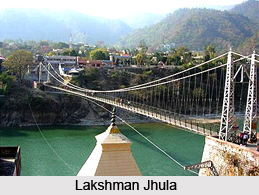 Lakshman Jhula is often visited by all those who visit Rishikesh. This is a hanging bridge which is situated at a distance of three kilometres from the township of Rishikesh. It stretches upto 450 kms across the Ganga River swinging at a height of 70 feet from the river. This jhula is often visited by the devotees who believe that once Lakshman, the younger brother of Shri Rama, crossed the river through a hanging bridge made up of jute. The ancient bridge is expected to have been located in the same place where the present bridge is located. Based on this legend the bridge was later on named as Lakshman Jhula. With the passage of time the jute bridge eroded and the iron bridge was built on the same sight in 1939.
Lakshman Jhula is often visited by all those who visit Rishikesh. This is a hanging bridge which is situated at a distance of three kilometres from the township of Rishikesh. It stretches upto 450 kms across the Ganga River swinging at a height of 70 feet from the river. This jhula is often visited by the devotees who believe that once Lakshman, the younger brother of Shri Rama, crossed the river through a hanging bridge made up of jute. The ancient bridge is expected to have been located in the same place where the present bridge is located. Based on this legend the bridge was later on named as Lakshman Jhula. With the passage of time the jute bridge eroded and the iron bridge was built on the same sight in 1939.
Lakshman Jhula has been considered as one of the most exciting tourist spots in Rishikesh. It is an adjoining bridge which connects the two popular shrines of Kedarnath and Badrinath. The Lakshman jhula is often known for its ancient origin and religious sanctity. Besides this the bridge is often used by the tourists to reach the flouring local market which is located around the temple. The bridge also leads to a thirteen storey ancient shrine which is commonly known as Tehar Manzil. This is mainly known for its scenic beauty. The top most step of the shrine provides an exotic look of the surrounding area. According to the local legends the Kund is considered quite auspicious as it is believed that Shri Rama and his brother Lakshman took a bath in this kund after killing Ravana to get rid of their sins. Surrounded with a number of religious shrines this is one of the most enchanting places of India. While the place creates mystic atmosphere it also entertains its visitors who can buy wooden artefacts along with other religious items to keep a memento of the area.
Thus known for its unique architecture and scenic beauty surrounded with a number of religious shrines this is one of the biggest attractions of North India. Surrounded with huge mountains and Ganges River this place shares some of the most enchanting sites of India.



















